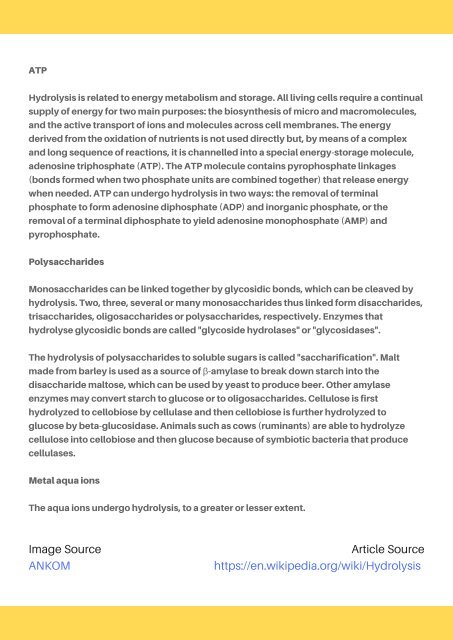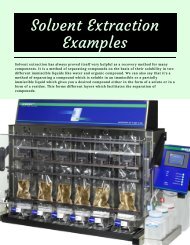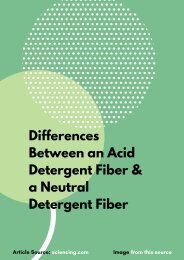Hydrolysis
Create successful ePaper yourself
Turn your PDF publications into a flip-book with our unique Google optimized e-Paper software.
ATP<br />
<strong>Hydrolysis</strong> is related to energy metabolism and storage. All living cells require a continual<br />
supply of energy for two main purposes: the biosynthesis of micro and macromolecules,<br />
and the active transport of ions and molecules across cell membranes. The energy<br />
derived from the oxidation of nutrients is not used directly but, by means of a complex<br />
and long sequence of reactions, it is channelled into a special energy-storage molecule,<br />
adenosine triphosphate (ATP). The ATP molecule contains pyrophosphate linkages<br />
(bonds formed when two phosphate units are combined together) that release energy<br />
when needed. ATP can undergo hydrolysis in two ways: the removal of terminal<br />
phosphate to form adenosine diphosphate (ADP) and inorganic phosphate, or the<br />
removal of a terminal diphosphate to yield adenosine monophosphate (AMP) and<br />
pyrophosphate.<br />
Polysaccharides<br />
Monosaccharides can be linked together by glycosidic bonds, which can be cleaved by<br />
hydrolysis. Two, three, several or many monosaccharides thus linked form disaccharides,<br />
trisaccharides, oligosaccharides or polysaccharides, respectively. Enzymes that<br />
hydrolyse glycosidic bonds are called "glycoside hydrolases" or "glycosidases".<br />
The hydrolysis of polysaccharides to soluble sugars is called "saccharification". Malt<br />
made from barley is used as a source of β-amylase to break down starch into the<br />
disaccharide maltose, which can be used by yeast to produce beer. Other amylase<br />
enzymes may convert starch to glucose or to oligosaccharides. Cellulose is first<br />
hydrolyzed to cellobiose by cellulase and then cellobiose is further hydrolyzed to<br />
glucose by beta-glucosidase. Animals such as cows (ruminants) are able to hydrolyze<br />
cellulose into cellobiose and then glucose because of symbiotic bacteria that produce<br />
cellulases.<br />
Metal aqua ions<br />
The aqua ions undergo hydrolysis, to a greater or lesser extent.<br />
Image Source<br />
Article Source<br />
ANKOM<br />
https://en.wikipedia.org/wiki/<strong>Hydrolysis</strong>






